Kariya, Aichi
Kariya (刈谷市, Kariya-shi) is a city in central Aichi Prefecture, Japan. As of 1 October 2019, the city had an estimated population of 153,162 in 66,751 households,[1] and a population density of 3,040 persons per km². The total area of the city is 50.39 square kilometres (19.46 sq mi).
Kariya 刈谷市 | |
|---|---|
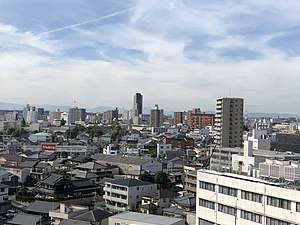 Upper:Kariya Highway Oasis Lower:Kariya Skyline | |
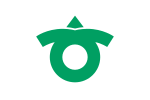 Flag  Seal | |
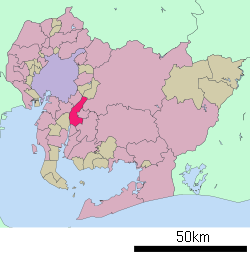 Location of Kariya in Aichi Prefecture | |
 Kariya | |
| Coordinates: 34°59′21.4″N 137°0′7.7″E | |
| Country | Japan |
| Region | Chūbu (Tōkai) |
| Prefecture | Aichi |
| Government | |
| Area | |
| • Total | 50.39 km2 (19.46 sq mi) |
| Population (October 1, 2019) | |
| • Total | 153,162 |
| • Density | 3,000/km2 (7,900/sq mi) |
| Time zone | UTC+9 (Japan Standard Time) |
| - Tree | Camphor Laurel |
| - Flower | Iris laevigata |
| Phone number | 0566-23-1111 |
| Address | 1-1 Tōyōchō, Kariya-shi, Aichi-ken 448-8501 |
| Website | Official website |
Geography
Kariya is situated in central Aichi Prefecture, on the Mikawa side of the border between former Owari Province and Mikawa Province. The area is flat and well-watered, with an average elevation of less than 10 meters above sea level.
Neighboring municipalities
Demographics
Per Japanese census data,[2] the population of Kariya has grown steadily over the past 70 years.
| Year | Pop. | ±% |
|---|---|---|
| 1950 | 50,384 | — |
| 1960 | 59,235 | +17.6% |
| 1970 | 87,672 | +48.0% |
| 1980 | 105,643 | +20.5% |
| 1990 | 120,126 | +13.7% |
| 2000 | 132,054 | +9.9% |
| 2010 | 145,744 | +10.4% |
Climate
The city has a climate characterized by hot and humid summers, and relatively mild winters (Köppen climate classification Cfa). The average annual temperature in Aisai is 15.7 °C. The average annual rainfall is 1578 mm with September as the wettest month. The temperatures are highest on average in August, at around 27.9 °C, and lowest in January, at around 4.4 °C.[3]
History
Kariya was a castle town in the Sengoku period, in an area contested between the Imagawa clan, Oda clan and various local warlords, including the Mizuno clan and Matsudaira clan. Tokugawa Ieyasu’s maternal grandfather Mizuno Tadamasa rebuilt Kariya Castle in the mid-16th century. The Mizuno clan shifted allegiances adroitly between the Imagawa clan to Oda Nobunaga and to Toyotomi Hideyoshi, who relocated the clan to Ise Province. However, Mizuno Katsunari, the grandson of Tadamasa was allowed to return to the clan's ancestral territories by Ieyasu after the Battle of Sekigahara as daimyō of Kariya Domain, a feudal han under the Tokugawa shogunate. The domain was reassigned to numerous clans during the Edo period, but was retained by the Doi clan from 1734 until the Meiji Restoration.
After the Meiji Restoration, Kariya Town was created within Hekikai District, Aichi Prefecture with the establishment of the modern municipalities system on October 1, 1889. The town prospered as a center for commerce, sake production, sericulture and ceramics due to its location on the main railway routes. The Yosami Transmitting Station, located in Kariya, was Japan's tallest structure when completed in 1929. Kariya achieved city status on April 1, 1950. The city expanded by annexation of neighboring Fujimatsu and most of Yosami villages on April 1, 1955. Control of the Yosami Transmitting Station was returned to Japan from the United States Navy in 1994, and the former facility is now a city park.
Government
Kariya has a mayor-council form of government with a directly elected mayor and a unicameral city legislature of 28 members. The city contributes two members to the Aichi Prefectural Assembly. In terms of national politics, the city is part of Aichi District 13 of the lower house of the Diet of Japan.
Economy
The economy of Kariya is dominated by companies related to the Toyota Group, including Toyota Industries Corporation, Aisin Seiki and Denso Corporation. Toyota Motor Corporation started as a division of Toyoda Automatic Loom Works (now called Toyota Industries Corporation). The Toyoda Automatic Loom Works was highly profitable and board members reinvested much of the profits into the growing automobile manufacturing business.
Education
- University and Colleges
- Schools
- Kariya has 15 public elementary schools and six public junior high schools operated by the city government, and four public high schools operated by the Aichi Prefectural Board of Education. There are also one public high schools operated by the national government.
- International School
- The Colégio Pitágoras Brasil, a Brazilian school was previously located in Kariya.[4]
Transportation
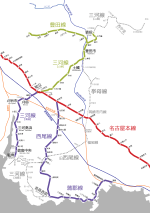
Highways

- Kariya Parking Area
- Aizuma river cycling road
Sports
The city is home to the SeaHorses Mikawa, 5-time champion of Japan's top professional basketball league.
- Men's
- SeaHorses Mikawa(Basketball・B.LEAGUE)
- JTEKT Stings(Volleyball・V.LEAGUE)
- Toyota Industries Shuttles(Rugby・Top Challenge League)
- Women's
Sister cities
.svg.png)
Local attractions
- Kijo Park
- Mando Matsuri
- Kijo Park
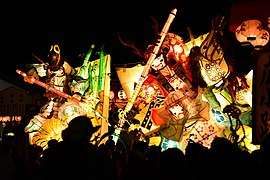 Mando Matsuri
Mando Matsuri
Notable people from Kariya
- Norihiro Akahoshi, professional baseball player
- On Kawara, artist
- Koji Kondo, professional soccer player
- Nobuyuki Sato, marathon runner
- Mitsunori Yoshida, professional soccer player
References
- Kariya City official statistics (in Japanese)
- Kariya population statistics
- Kariya climate data
- "Escolas Brasileiras Homologadas no Japão" (Archive). Embassy of Brazil in Tokyo. February 7, 2008. Retrieved on October 13, 2015.
- "International Exchange". List of Affiliation Partners within Prefectures. Council of Local Authorities for International Relations (CLAIR). Archived from the original on 24 December 2015. Retrieved 21 November 2015.
External links
| Wikimedia Commons has media related to Kariya, Aichi. |
- Official website (in Japanese)
- Kariya City official website (in English)
- Mississauga Sister City Site (in English)